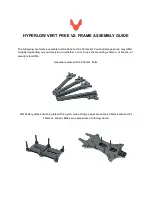
Certain types of conditions will justify the use of a leash while stand up paddle boarding. The leash
connects the rider to the board. A leash will be required when in waves and on fl at water in an open
or closed bodies of water with no currents. The leash must be installed this way:
Untie the string connected to your leash, then
pass it into the leash plug and tie it in a clove
hitch, then reconnect your leash to the string.
Do not use your SUP without a leash when the
conditions require one. Losing contact with
your board can be dangerous or yourself and to
others around you. Always use a leash in good
condition and make sure that it is at least as
long as your SUP.
It is also necessary to adapt the diameter of the
leash to the size of the board. Choose a leash
at least 7 mm thick for the small SUP’s (<8’5’’)
and a diameter of 8 mm or bigger for the bigger
boards.
F-ONE offers paddles that are adjustable and
others that are a fi xed length to reduce weight. If
you acquired a non adjustable paddle, you need
to cut the paddle to the right length for your size
and discipline, then glue on the supplied handle.
To defi ne the right length shaft, your paddle needs
to be about 10 to 20 cm taller then you.
The wave paddle is shorter (closer to the water)
than a race board paddle that needs to be lon-
ger (race boards fl oat higher). If you are unsure,
remember you are better off cutting too long than
too short.
Once you have determined the correct length of the shaft, cut it
down with a metal saw. Do not forget to tape the area where you
are cutting to mark the spot and to stop the carbon from splitting.
The handle slides inside the shaft, remember to align the handle
at the right angle correlated to the paddle at the other end. The
handle must be parallel with the blade and the concave side of
the handle must be on the same side as the back of the blade.
1
4
2
5
3
Installing the leash
Cutting the paddle
FRANÇAIS
ENGLISH
19
Содержание Stand Up Paddle
Страница 12: ...12...
Страница 13: ...FRAN AIS ENGLISH 13...






































